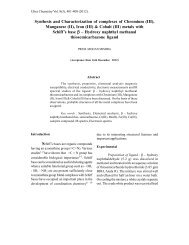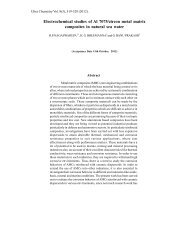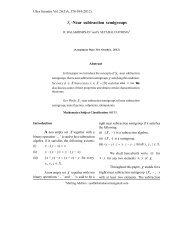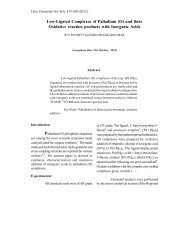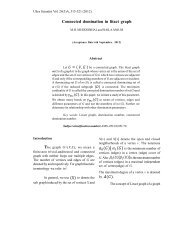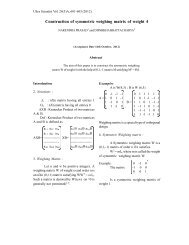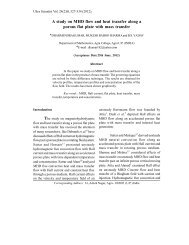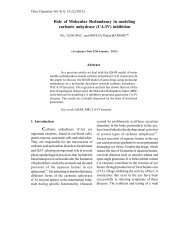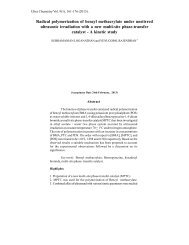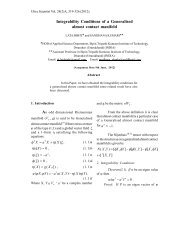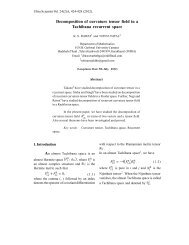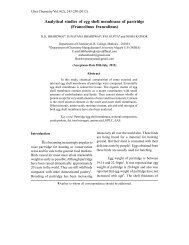D:\Ultra-157 (1)13.pmd - Ultrascientist.org
D:\Ultra-157 (1)13.pmd - Ultrascientist.org
D:\Ultra-157 (1)13.pmd - Ultrascientist.org
You also want an ePaper? Increase the reach of your titles
YUMPU automatically turns print PDFs into web optimized ePapers that Google loves.
Ultra Scientist Vol. 25(1)B, <strong>157</strong>-162 (2013).<br />
Synthesis and Spectral Characterization of Oxo- and<br />
di-Oxo-Transition Metal Chelates of 2-aminothiophenol<br />
and 2-aminophenol<br />
R.N. PANDEY* and PRAMILA SHARMA a<br />
(Acceptance Date 27th Febuary, 2013)<br />
Abstract<br />
Squarepyramidal chelates of VO ++ , oxo-bridged octahedral<br />
chelates of VO 2 + and octahedral cis-dioxo chelates of MoO 2 ++ and WO 2<br />
++<br />
are prepared using 2-aminothiphenol and 2-aminophenol as chelating<br />
agents. The possible structures are deducted in the light of results from<br />
elemental analysis, magnetic susceptibility, electrical conductivity<br />
measurements, IR, UV-vis, ‘H NMR and ESR Spectra. The persistent of<br />
ZrO ++ group is lacking in octahedral bis-chelate of oxo-zirconium (iv).<br />
Key words : VO 2<br />
+<br />
, VO ++ , ZrO ++ , MoO 2 ++ and WO 2 ++ species<br />
chelates, 2-aminothiophenol, 2-aminophenol.<br />
Introduction<br />
Metal chelates of 2- aminothiophenol<br />
are investigated by several workers 1-3 . A<br />
perusal of the literature reveal that no work<br />
has been done on dº-oxocations like, VO ++ ,<br />
ZrO ++ , ,<br />
and which may display a great variety<br />
of coordination geometries and very interesting<br />
insights into structure and bonding 4-6 . These<br />
oxo-cations are related with several bio-chemical<br />
problems 7-9 and we have reported some novel<br />
complexes of these ions with thioamide<br />
ligands 10-12 . The present study aims at synthesis<br />
and spectral characterization of these oxocations<br />
with 2-aminothiophenol and 2-aminophenol.<br />
Experimental<br />
The ligands, 2-aminothiophenol<br />
(Schuchardt, Munchen) and 2-aminophenol<br />
(Ward Blenkinsop, London) and other chemicals<br />
used were either of AR grade or were CP-
158 R.N. Pandey, et al.<br />
grade. All complexes were prepared using our<br />
general method reported earlier 10-12 .<br />
IR Spectra were recorded on a Perkin<br />
Elmer 577 Spectrometer, electronic spectra on<br />
a Backmann DV-6 Spectrometer, 'HMR<br />
(CDCl 3 ) on a JEO 2 JMS 60011 NMR Spectrometer,<br />
ESR spectra on Varian Associate<br />
Spectrophotometer using 100 KHZ, X-band<br />
(RT), Scan range 2.0 x 1 Kg and field set 3200<br />
and molar conductance (10 -3 M) of complexes<br />
were measured in DMF using Wiss-werkstatter<br />
Weithein obb type LBR conductivity meter.<br />
Magnetic moment was measured on a gouy<br />
balance using Hg[Co(SCN) 4 ] as calibrant.<br />
Analysis :<br />
Sl.No. 1 : For [VO(SC 6<br />
H 4<br />
NH 2<br />
) 2<br />
].4H 2<br />
O :<br />
Found(%) : C, 37.34; H, 5.21; N, 7.20; V, 13.20;<br />
Calculated (%): C, 37.20; H, 5.16; N, 7.23;<br />
V, 13.17;<br />
Sl.No. 2 :For VO(OC 6<br />
H 4<br />
NH 2<br />
) 2<br />
].3H 2<br />
O :<br />
Found(%) : C, 42.68; H, 5.31; N, 8.28; V, 15.10;<br />
Calculated (%): C, 42.72; H, 5.34; N, 8.30;<br />
V, 15.13;<br />
Sl.No. 3 : For [V 2<br />
O 3<br />
(S-C 6<br />
H 4<br />
-NH 2<br />
) 4<br />
] :<br />
Found(%) : C, 44.55; H, 4.32; N, 8.72; V, 15.68;<br />
Calculated (%): C, 44.58; H, 4.33; N, 8.66;<br />
V, 15.78;<br />
Sl.No. 4 : For [V 2<br />
O 3<br />
(O-C 6<br />
H 4<br />
-NH 2<br />
) 4<br />
] :<br />
Found(%) : C, 49.44; H, 4.80; N, 9.72; V, 17.55;<br />
Calculated (%): C, 49.48; H, 4.81; N, 9.62;<br />
V, 17.52;<br />
Sl.No. 5 : For [MoO 2<br />
(S-C 6<br />
H 4<br />
-NH 2<br />
) 2<br />
]:<br />
Found(%) : C, 38.12; H, 3.00; N, 7.52; Mo,<br />
25.20;<br />
Calculated (%): C, 38.29; H, 3.19; N, 7.44;<br />
Mo, 25.53;<br />
Sl.No. 6 : For [MoO 2<br />
(O-C 6<br />
H 4<br />
-NH 2<br />
) 2<br />
]:<br />
Found(%) : C, 38.11; H, 3.18; N, 7.52; Mo, 25.09;<br />
Calculated (%): C, 38.29; H, 3.19; N, 7.44;<br />
Mo, 25.53;<br />
Sl.No. 7 : For [WO 2<br />
(S-C 6<br />
H 4<br />
-NH 2<br />
) 2<br />
]:<br />
Found(%) : C, 31.21; H, 2.55; N, 6.11; W, 39.55;<br />
Calculated (%): C, 31.04; H, 2.58; N, 6.03;<br />
W, 39.64;<br />
Sl.No. 8 : For [WO 2<br />
(O-C 6<br />
H 4<br />
-NH 2<br />
) 2<br />
]:<br />
Found(%) : C, 33.21; H, 2.58; N, 6.66; W,<br />
42.47;<br />
Calculated (%): C, 33.34; H, 2.77; N, 6.48;<br />
W, 42.57;<br />
Sl.No. 9 : For [ZrO(H 2<br />
O)(S-C 6<br />
H 4<br />
-NH 2<br />
) 2<br />
].<br />
2H 2<br />
O:<br />
Found(%) : C, 35.12; H, 4.33; N, 6.68; Zr,<br />
22.11;<br />
Calculated (%): C, 35.18; H, 4.39; N, 6.84;<br />
Zr, 22.29;<br />
Sl.No. 10 : For [ZrO(H 2<br />
O)(O-C 6<br />
H 4<br />
-NH 2<br />
) 2<br />
].<br />
3H 2<br />
O:<br />
Found(%) : C, 36.16; H, 4.98; N, 6.89; Zr, 23.10;<br />
Calculated (%): C, 36.43; H, 5.06; N, 7.08;<br />
Zr, 23.08;<br />
Results and Discussion<br />
Elemental analysis of the metal<br />
chelates confirmed their proposed stoichiometry<br />
given experimental section. These bis-chelates<br />
of all oxo-cations were found to be insoluble<br />
in most of solvents. However, they were fair<br />
soluble in DMF and DMSO. The 10 -3 M solution
Synthesis and Spectral Characterization---2-aminothiophenol and 2-aminophenol. 159<br />
of complexes exhibited molar conductance less<br />
than 10 ohm -1 cm 2 mol -1 indicating their nonelectrolytic<br />
nature and anions are present in<br />
the inner sphere of the complexes. All complexes<br />
were found to be diamagnetic indicating dºconfiguration<br />
of VO 2<br />
+<br />
, ZrO ++ , MoO 2 ++ , and<br />
WO 2<br />
++<br />
species. The magnetic moment of oxovanadium<br />
(iv) chelates were observed between<br />
1.66-1.67 BM, which are close to the spin value<br />
(1.73 BM) for one unpaired electron. The<br />
magnetic moment value suggested their<br />
monomeric nature and absence of metal-metal<br />
interaction was assumed. The electronic spectra<br />
of oxo-vanadium (iv) complexes exhibited<br />
three bands at 12315 cm -1 ( 2 B 2 2 E), 17670cm -1<br />
( 2 B 2 2 B 1 ) and 23255 cm -1 ( 2 B 1 2 A 1 ) suggesting<br />
Squarepyramidal structure (Str. II) of fivecoordinated<br />
complexes. The Squarepyramidal<br />
Stereochemistry of these oxo-vanadium (iv)<br />
complexes are in good agreement with those<br />
achieved earlier 13-15 . Other bands of high<br />
intensity in ultra-violet region are assigned to<br />
intraligand charge transfer.<br />
All diamagnetic complexes of VO 2 + ,<br />
ZrO ++ , MoO 2<br />
++<br />
and WO 2<br />
++<br />
cations exhibits no<br />
absorption bands between 12500cm -1 to<br />
25000cm -1 as expected for metal ions with<br />
(n-1)dºnsº electronic configuration 16 . However,<br />
two strong bands in the UV region was<br />
observed due to intraligand charge transfer.<br />
IR Spectra :<br />
The IR bands of interest of the ligands<br />
and complexes are discussed here. A comparison<br />
of spectra of ligands and complexes indicate<br />
the simultaneous Metal-S and Metal-N (ATP)<br />
and Metal-O and Metal-N (AP) bonding in all<br />
complexes. The sH (2530 cm -1 ) band of 2-<br />
aminothiophenol (ATP) and o-H (3480cm -1 )<br />
band of 2-aminophenol (AP) was abscent from<br />
the spectra of complexes and deprotonation<br />
of thiol hydrogen and phenolic –OH of ligands<br />
on complexation was assumed 17 . The ligand,<br />
2-aminophenol shows sharp sym NH 2<br />
(3300cm -1 ) and asym NH 2 (3380 cm -1 ), <br />
C-O (1220 cm -1 ) and out of plane CH bending<br />
mode (740cm -1 ) are observed at 3285 cm -1 ,<br />
3370 cm -1 , 1200 cm -1 and 745 cm -1 on complexation<br />
respectively and coordination through<br />
amino nitrogen and phenolic oxygen was<br />
assumed 1 . New bands at 460-445 cm -1 and at<br />
515-510 cm -1 in the Spectra of complexes due<br />
to stretching mode also supported the formation<br />
of metal –N and Metal –O bond respectively.<br />
The bands at 3340 cm -1 (sym NH 2 ),<br />
3460 cm -1 ( asym NH 2 ) and at 2560 cm -1<br />
(SH) in the Spectrum of 2-aminothiophenol<br />
displayed major change. The first two bands<br />
red shift to lower frequency about 40-50 cm -1<br />
and 60-65 cm -1 and third band was not observed<br />
in the Spectra of all complexes indicating the<br />
formation of M-N and M-S bonds 17 .<br />
The dioxo-vanadium(v) complexes<br />
exhibited non-ligand medium intensity broad<br />
band in the region 3485-3415 cm -1 along with<br />
a medium band at 840 cm -1 assigned for the<br />
V-O-V stretching vibration which suggest the<br />
formation of H-oxo-bridged vanadium(v)<br />
complex 18 . 2-aminothiophenol also forms oxobridging<br />
Fe-O-Fe system in Fe(III) complex<br />
and two sharp but weak bands at 866 and 846<br />
cm -1 are reported by Singh et al. 1 .
160 R.N. Pandey, et al.<br />
The absence of a band in the region<br />
840-950cm -1 due to Zr=O stretch in zirconium<br />
(iv) complex suggests its formulation as<br />
[Zr(OH) 2 (S-C 6 H 4 -NH 2 ) 2 ] and not as [ZrO(H 2 O)<br />
(S-C 6 H 4 -NH 2 ) 2 ]. This observation is further<br />
supported the presence of a broad band at 3445<br />
cm -1 and the appearance of a new band of<br />
medium intensity at 1140 cm -1 due to the Zr-<br />
OH banding 19 mode support the Str. I of the<br />
present ZrO(iv) complexes.<br />
All the MoO 2<br />
++<br />
and WO 2<br />
++<br />
complexes<br />
exhibited two bands (900 and 865cm -1 ) and<br />
(890 & 860 cm -1 ) assignable to the two Mo=O<br />
and W=O stretching modes respectively. The<br />
presence of two bands is consistent with the<br />
cis-dioxo structure of the MoO 2<br />
++<br />
and WO 2<br />
++<br />
groups 10-11,19 (Str. IV).<br />
'H NMR Spectra :<br />
The 'H NMR Spectra (CDCl 3 ) of<br />
ligands and oxo-vanadium (iv) complexes were<br />
recorded to investigate further mode of metalligand<br />
bonding. The free ligands, 2-aminophenol<br />
and 2-amino thiophenol displayed<br />
signals at 8.92 and 3.68 PPM respectively<br />
due to intramolecularly hydrogen bonded<br />
phenolic and thiol protons. These protons<br />
disappeared from the Spectra of complexes<br />
indicating their replacement by metal ion during<br />
complexation 20 . The aryl proton signals are<br />
observed in the range of 6.42 – 6.68 PPM<br />
(AP) and 6.64-7.30 PPM(ATP) as complex<br />
multiplet are slightly low field shifted and the<br />
integrated intensities of these signals agree<br />
well with the formulation of the complexes.<br />
The amino protons of ligands observed at<br />
4.40 PPM (AP) and 3.68 PPM (ATP) are<br />
low filed shifted on complexation and the<br />
integrated intensities of the signals agree well<br />
with structure (Str. II). Thus, these observations<br />
are consistent with the conclusion drawn from<br />
IR Spectral data.<br />
ESR Spectra :<br />
The X-band ESR Spectra of Oxo<br />
Vanadium(iv) Complexes with room temperature<br />
(300 k) in DMSO solution shows normal<br />
eight lines isotropic features revealing<br />
hyperfine splitting of the 51 V nucleus I=7/2<br />
which indicate that a single vanadium is present<br />
in the molecule and monomer. The magnetic<br />
and bonding parameters deducted from spectra<br />
are in table 2.<br />
Table 2.<br />
ESR spectral data of ATP-VO(iv) and<br />
AP-VO(iv) complexes.<br />
Parameters ATP-VO(iv) AP-VO(iv)<br />
g II 1.9712 1.9702<br />
g I 1.9886 1.98873<br />
g av 1.9802 1.9810<br />
2 0.54 0.53<br />
The observed data indicated that g II<br />
and g I values are close to 2 and g II
Synthesis and Spectral Characterization---2-aminothiophenol and 2-aminophenol. 161<br />
Table 1<br />
Major IR and 'H NMR Spectral data of ligands and complexes<br />
Compds. IR (cm -1 ) 'H NMR (PPM)<br />
SH a NH 2 / M=O Amino -OH/ Phenyl<br />
s NH 2 ) Proton (-sH) Proton<br />
(-NH 2<br />
)<br />
ATP (ligand) 2560 w 3460 m - 3.68 - 6.64-7.30<br />
(3340 m) 3.66 (multiplet)<br />
VO(iv)-complex - 3405 m 820 m 3.54 - 6.62-7.11<br />
(Sl. No. 1) (3310 m) (-) multiplet<br />
+<br />
VO 2 - complex - 3400 (m) 810 m - - -<br />
(Sl. no.-3) (3310 m) (-)<br />
++<br />
MoO 2 -complex - 3400 m 900 m - - -<br />
(Sl. no.-5) (3300 m) 860 m (-)<br />
WO ++ 2 - complex - 3410 m 890 m - - -<br />
(Sl. no.-7) (3310 m) 865 m (-)<br />
ZrO ++- complex - 3400 m - - - -<br />
(Sl. no.-9) (3305 m) (-)<br />
AP (ligand) - 3380 mb - 4.40 - 6.42-6.68<br />
3300 mb (-) multiplet<br />
VO ++- complex - 3370 m 830 m 4.12- - 6.32-6.88<br />
(Sl. no.-2) 3290 m 4.41 (-)<br />
(split)<br />
+<br />
VO 2 - complex - 3360 m 840 m - - -<br />
(Sl. no.-4) 3280 m (-)<br />
MoO ++ 2 -complex - 3350 m 900 m - - -<br />
(Sl. no.-6) 3270 m 860 m (-)<br />
WO ++ 2 - complex - 3370 m 880 m - - -<br />
(Sl. no.-8) 3265 m 850 m (-)
162 Ultra Scientist Vol.25(1)B, (2013).<br />
OH<br />
H 2<br />
N<br />
X<br />
Zr<br />
NH<br />
X<br />
2 OH<br />
(x = 0/s)<br />
(Str. I)<br />
.xH 2O<br />
(Octa-hedral-Structure)<br />
X<br />
O<br />
V<br />
NH 2<br />
O<br />
S<br />
V<br />
NH 2<br />
O<br />
X<br />
S<br />
N<br />
H 2<br />
(x = 0/s)<br />
(Str. III)<br />
References<br />
2<br />
X<br />
NH 2<br />
O<br />
V<br />
X<br />
N<br />
H 2<br />
(x = 0/s)<br />
(Str. II)<br />
.xH 2O<br />
(Square Pyramidal Structure)<br />
O<br />
X<br />
NH 2<br />
1. B. Singh and R.V. Choudhary, Indian J.<br />
Chem. Vol. 13, 926 (1975).<br />
2. L.F. Larkworthy, J. M. Murphy and D.J.<br />
Phillips, In<strong>org</strong>. Chem. 7, 1436 (1968).<br />
3. R. John Wasson, J. Shirley Wasson and<br />
M.G. Watermann, In<strong>org</strong>. Chem. 9, <strong>157</strong>6<br />
(1970).<br />
4. R.C. Fay, Coord. Chem. Rev. 37, 41 (1981);<br />
45, 41 (1982); 52, 285 (1983).<br />
5. K.C. Das, J. Indian Chem. Soc. 66, 562<br />
(1989).<br />
6. D. A. Rice, Coord. Chem. Rev. 37, 61<br />
(1981); 45, 67(1982).<br />
7. A. Butler and C.J. Carrano, Coord. Chem.<br />
Rev. 109, 61 (1991).<br />
8. W.E. Newton and S. Otsuka, ‘Molybdenum<br />
chemistry of Biological Significance’,<br />
M<br />
O<br />
H 2<br />
N<br />
X<br />
(x = 0/s; M = Mo/w)<br />
(Str. IV)<br />
<br />
(Oxo-bridged- VO -complex)<br />
<br />
(Cis-dioxo- MO -complex)<br />
2<br />
Plenum, London, (1980).<br />
9. H. Sakkurai, A. Tamura, J. Fugono, H.<br />
Yasui and T. Kiss, Coord. Chem. Rev.<br />
245, 31 (2003).<br />
10. R.N. Pandey, R.N. Sharma, L.M. Roy<br />
Choudhary and (Mrs.) Pramila Sharma,<br />
J. Indian Chem. Soc. Vol. 69, 719 (1992).<br />
11. R.N. Pandey, L.M. Roy Choudhary, (Mrs.)<br />
Pramila Sharma, A.N. Sahay and R.N.<br />
Sharma, Indian J. Chem. 32A, 450 (1993).<br />
12. R.N. Pandey and Kalpna Shahi, Asian J.<br />
Chem. Vol. 23 (No 10), 4508 (2011), Vol.<br />
23, (No. 10), 4467 (2011).<br />
13. R.K. Mohapatra, J. Indian Chem. Soc.<br />
Vol. 87, 1251 (2010).<br />
14. A.A. Ahmed, S.A. Benguzzi and M.O.<br />
Ahshad, Rasan J. Chem. 2, 781 (2009).<br />
15. S.N. Shetti, A.S.R. Murty and G.L. Tembe,<br />
J. Indian Chem. Soc. Vol. 73, 91 (1996).<br />
16. T.M. Dunn, R.S. Nyholm and S. Yamada,<br />
J. Chem. Soc., 1564 (1962).<br />
17. R.N. Pandey and A.K. Nag, J. Ultra<br />
Chem. Vol. 8(3), 329 (2012).<br />
18. P.B. Chatterjee, D. Mandal, A. Audhya,<br />
K.Y. Choi, A. Endo and M. Chaudhary,<br />
In<strong>org</strong>. Chem. 47, 3709 (2008).<br />
19. D. Kumar, A. Syamal, A.Kumar, P.K.<br />
Gupta and Das, J. Indian Chem. Soc. Vol.<br />
87, 417 (2010).<br />
20. K. Krishnan Kutty, M.B. Ummathur and<br />
P. Sayudevi, J. Argent. Chem. Soc. 96,<br />
13 (2008).<br />
21. S.J. Swamy and K. Bhaskar, Indian J.<br />
Chem. Sect. A, 84, 963 (1999).



